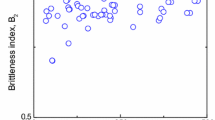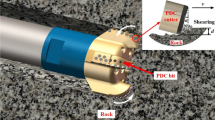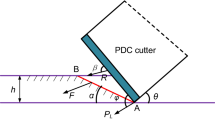Abstract
Polycrystalline Diamond Compact (PDC) bit is extensively used in oil & gas drilling, the rock cutting efficiency of PDC cutter directly determines the drilling efficiency and costs. Hence, it is crucial to evaluate the rock cutting efficiency of PDC cutters. The Mechanical Specific Energy (MSE) is used as an index for long periods of time to evaluate the rock cutting efficiency, however, the energy dissipation in rock breaking cannot be further calculated in details, leading to inaccuracy. To address this problem, the new concept of Plastic Energy Dissipation Ratio (PEDR) and its model are presented, a new approach for rock cutting efficiency evaluation by using PEDR is also put forward. Compared with MSE, the PEDR can determine the Optimum Depth of Cut (DOC) under various conditions. The theoretical analysis shows that the critical DOC, governing the transition of ductile to brittle failure mode, is the optimal cutting depth, having the smallest PEDR and highest rock cutting efficiency. The test and simulation of rock cutting are carried out to verify the PEDR model, and the PEDR under different DOC, cutting velocities and rake angles are depicted and discussed. The results can provide a theoretical basis for the design of PDC cutter and optimization of drilling parameters.
Similar content being viewed by others
References
Akbari, B. (2011). Polycrystalline diamond compact bit-rock interaction, Memorial University of Newfoundland.
Akbari, B., Miska, S., Yu, M., and Ozbayoglu, E. (2014a). Relation between the mechanical specific energy, cuttings morphology, and PDC cutter geometry, ASME Paper No. OMAE2014-24708, pp. V005T11A038, DOI: 10.1115/OMAE2014-24708.
Akbari, B., Miska, S. Z., Yu, M., and Rahmani, R. (2014b). “The effects of size, chamfer geometry, and back rake angle on frictional response of PDC cutters.” 48 th US Rock Mechanics/Geomechanics Symposium, American Rock Mechanics Association, ARMA 14–7458, Minneapolis, MN, USA.
Altindag, R. (2003). “Correlation of specific energy with rock brittleness concepts on rock cutting.” Journal of the South African Institute of Mining and Metallurgy, Vol. 103, No. 3, pp.163–171.
Arcona, C. and Dow, T. A. (1998). “An empirical tool force model for precision machining.” Journal of Manufacturing Science and Engineering, Vol. 120, No. 4, pp. 700–707, DOI: 10.1115/1.2830209.
Atici, U. and Ersoy, A. (2009). “Correlation of specific energy of cutting saws and drilling bits with rock brittleness and destruction energy.” Journal of Materials Processing Technology, Vol. 209, No. 5, pp. 2602–2612, DOI: 10.1016/j.jmatprotec.2008.06.004.
Bifano, T. G., Dow, T. A., and Scattergood, R. O. (1991). “Ductileregime grinding: a new technology for machining brittle materials.” Journal of Manufacturing Science and Engineering, Vol. 113, No. 2, pp. 184–189, DOI: 10.1115/1.2899676.
Bilgesu, I., Sunal, O., Tulu, I. B., Heasley, K. A. (2008). “Modeling rock and drill cutter behavior.” 42nd US Rock Mechanics Symposium & 2nd US-Canada Rock Mechanics Symposium, San Francisco, CA, USA.
Carrapatoso, C., Fontoura, S. A. B., Martinez, I. M. R., Inoue, N., Lourenço, A., and Curry, D. (2013). “Simulation of single cutter experiments in evaporite through discrete element method.” In ISRM Internation Symposium - EUROCK 2013, International Society for Rook Mechanics and Rook Engineering, Wroclaw, Poland.
Chen, S., Grosz, G., Anderle, S., Arfele, R., and Xun, K. (2015). “The role of rock-chip removals and cutting-area shapes in polycrystallinediamond-compact-bit design optimization.” SPE Drilling & Completion, SPE 171833, DOI: 10.2118/17183 3-PA.
Detournay, E. and Tan, C. P. (2002). “Dependence of drilling specific energy on bottom-hole pressure in shales.” SPE/ISRM Rock Mechanics Conference, Society of Petroleum Engineers, SPE/ISRM 78221, DOI: 10.2118/78221-MS.
Itasca, C.G. (2002). Users’ manual for particle flow code in 2 dimensions (PFC2D), Minneapolis, Minnesota, USA.
Karekal, S. (2012). “Modeling Rock chipping process in linear drag cutting mode.” ISRM International Symposium - EUROCK 2012, International Society for Rock Mechanics, Stockholm, Sweden.
Liu, W., Zhu, X., and Jing, J. (2018). “The analysis of ductile-brittle failure mode transition in rock cutting.” Journal of Petroleum Science and Engineering, Vol. 163, pp. 311–319, DOI: 10.1016/j.petrol.2017.12.067.
Marshail, D. B. (1983). “Geometrical effects in elastic/plastic indentation.” Journal of the American Ceramic Society, Vol. 67, No. 1, pp. 57–60, DOI: 10.1111/j.1151-2916.1984.tb19148.x.
Mendoza, R. J. A. (2010). Modeling rock cutting using DEM with crushable particles, PhD Thesis, University of Pittsburgh, Pittsburgh, PA, USA.
Mendoza, R. J. A. (2013). Considerations for discrete element modeling of rock cutting, PhD Thesis, University of Pittsburgh, Pittsburgh, PA, USA.
Mendoza, J. A., Gamwo, I. K., Zhang, W., and Lin, J. S. (2013b). “Considerations for discrete modeling of rock cutting.” 45th US Rock Mechanics/Geomechanics Symposium, American Rock Mechanics Association, ARMA-11-210, San Francisco, CA, USA.
Menezes, P. L., Lovell, M. R., Avdeev, I. V., and Higgs, C. F. (2014a). “Studies on the formation of discontinuous rock fragments during cutting operation.” International Journal of Rock Mechanics and Mining Sciences, Vol. 71, pp. 131–142, DOI: 10.1016/j.ijrmms.2014.03.019.
Menezes, P. L., Lovell, M. R., Avdeev, I. V., and Higgs, C. F. (2014b). “Studies on the formation of discontinuous chips during rock cutting using an explicit finite element model.” The International Journal of Advanced Manufacturing Technology, Vol. 70, Nos. 1–4, pp. 635–648, DOI: 10.1007/s00170-013-5309-y.
Menezes, P. L., Lovell, M. R., Lin, J. S., and III, C. F. H. (2009). “Finite Element modeling of discontinuous chip formation during rock cutting.” ASME/STLE 2009 International Joint Tribology Conference, American Society of Mechanical Engineers, pp. 463–465, DOI: 10.1115/IJTC2009-15197.
Munoz, H., Taheri, A., and Chanda, E. K. (2016). “Rock drilling performance evaluation by an energy dissipation based rock brittleness index.” Rock Mechanics and Rock Engineering, Vol. 49, No. 8, pp. 3343–3355, DOI: 10.1007/s00603-016-0986-0.
Pei, J. Y. (2012). “Interpretation of single cutter tests for rock mechanical properties.” 46th US Rock Mechanics/Geomechanics Symposium, American Rock Mechanics Association, ARMA 12–142, Chicago, IL, USA.
Rajabov, V., Miska, S. Z., Mortimer, L., Yu, M., and Ozbayoglu, M. E. (2012). “The effects of back rake and side rake angles on mechanical specific energy of single PDC cutters with selected rocks at varying depth of cuts and confining pressures.” IADC/SPE Drilling Conference and Exhibition, Society of Petroleum Engineers, DOI: 10.2118/151406-MS
Reyes, M. I., Fontoura, S., Inoue, N., Carrapatoso, C., Lourenco, A., and Curry, D. (2013). “Simulation of single cutter experiments in evaporites through finite element method.” SPE/IADC Drilling Conference, Society of Petroleum Engineers, SPE/IADC 163504.
Sunal, O. (2009). Parametric study of a single PDC cutter with a numerical model, MSc Thesis, West Virginia University, Morgantown, WV, USA.
Teale, R. (1965). “The concept of specific energy in rock drilling.” International Journal of Rock Mechanics and Mining Sciences & Geomechanics Abstracts, Vol. 2, No. 1, pp. 57–73, DOI: 10.1016/0148-9062(65)90016-1.
Tulu, I. B. (2009a). Modeling PDC cutter rock interaction, MSc Thesis, West Virginia University, Morgantown, WV, USA.
Tulu, I. B. and Heasley, K. A. (2009b). “Calibration of 3D cutter-rock model with single cutter tests.” 43rd US Rock Mechanics Symposium & 4th US-Canada Rock Mechanics Symposium, American Rock Mechanics Association, ARMA 09–160, Asheville, NC, USA.
Zhang, Q. Q., Han, Z. N., Zhang, M. Q., and Zhang, J. G. (2015). “Prediction of tool forces in rock cutting using discrete element method.” Electronic Journal of Geotechnical Engineering, Vol. 20, No. 5, pp. 1607–1625.
Zhao, D., Liu, J. Q., and Guo, W. (2012). “The simulation of cutter-rock interaction in PFC.” Applied Mechanics and Materials, Vols. 170–173, pp. 3385–3389, DOI: 10.4028/www.scientific.net/AMM.170-173.3385.
Zhou, Y. (2013b). Numerical modeling of rock drilling with finite elements, PhD Thesis, University of Pittsburgh, Pittsburgh, PA, USA.
Zhou, Y. and Lin, J. S. (2013a). “On the critical failure mode transition depth for rock cutting.” International Journal of Rock Mechanics and Mining Sciences, Vol. 62, pp. 131–137, DOI: 10.1016/j.ijrmms.2013.05.004.
Zhou, Y. and Lin, J. S. (2014). “Modeling the ductile–brittle failure mode transition in rock cutting.” Engineering Fracture Mechanics, Vol. 127, pp. 135–147, DOI: 10.1016/j.engfracmech.2014.05.020.
Zhou, Y., Jaime, M. C., Gamwo, I. K., Zhang, W., and Lin, J. S. (2011). “Modeling groove cutting in rocks using finite elements.” 45th US Rock Mechanics/Geomechanics Symposium, American Rock Mechanics Association, ARMA 11–209, San Francisco, CA, USA.
Zhou, Y., Zhang, W., Gamwo, I. K., Lin, J. S., Eastman, H., Whipple, G., and Gill, M. (2012). “Mechanical specific energy versus depth of cut.” 46 th US Rock Mechanics/Geomechanics Symposium, American Rock Mechanics Association, ARMA 12–622, Chicago, IL, USA.
Zhu, X., Liu, W., and He, X. (2017). “The investigation of rock indentation simulation based on discrete element method.” KSCE Journal of Civil Engineering, Vol. 21, No. 4, pp. 1201–1212, DOI: 10.1007/s12205-016-0033-4.
Author information
Authors and Affiliations
Corresponding author
Rights and permissions
About this article
Cite this article
Liu, W., Zhu, X. A New Approach of Rock Cutting Efficiency Evaluation by using Plastic Energy Dissipation Ratio. KSCE J Civ Eng 23, 879–888 (2019). https://doi.org/10.1007/s12205-018-0100-0
Received:
Revised:
Accepted:
Published:
Issue Date:
DOI: https://doi.org/10.1007/s12205-018-0100-0




